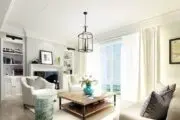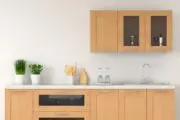
It’s not uncommon for a house hunter to fall fully in love during a model home tour. Model homes are meant to be inspirational and aspirational as well as demonstrate builder upgrade options.
But how can homeowners recreate the look and feel the same love in their own homes, especially if selecting all of the upgrades displayed isn’t an option?
It starts with looking at your new build through the eyes of a model home designer and using some of their strategies.
Use the model home for inspiration
Model homes are designed intentionally, with special consideration to lifestyle aspects that are likely to appeal to you- the new homeowner.
Adopt an observational mindset during your model home tour. What about the home appeals to you, specifically, and why?
Pay particular attention to lighting, color palette, accents and furniture choice and placement. Also note flow (both physically and conceptually) in a space and from room to room and the length of sightlines.
Also think about how each room communicates its intended purpose, which is another ever-present design trick in model homes.
Erica Bell, marketing manager at Miller & Smith says that the goal with their models is to show “potential residents how they can live in a space comfortably, efficiently, and aesthetically.”
“The model home showcases features and details that stick with you after a visit is over, be it a stylish gourmet kitchen, a smart home office, or simply use of space,” says Bell.
Create memorable focal points
If a certain space has grabbed you by the heart during your model home tour, chances are you are viewing a carefully crafted memory point. Memory points are created with wow factor in mind, to help fuse an emotional connection with buyers, a key part of transitioning prospective homebuyers to homeowners.
You can accomplish the same idea by creating special focal points that will re-kindle love for your home over and over.
Start by deciding which area in a room naturally draws the eye, and start from there, which is what the pros do.
“Just like we do when designing the models, find the most central, standout thing, like amazing windows or a fireplace, and let it shine,” says Lisa Briand, president, Ultimate Builder Services, LLC.
Accent walls are an easy and effective way to create a focal point and can be as simple as painting a wall a striking accent color.
Even simple wooden trim is effective, “with the wall painted one color. It adds dimension to the wall and it’s very simple for someone to do at home,” says Briand.
Shiplap is also trending for accent walls. “We love shiplap on a focal wall over a fireplace and painted a really rich color,” says Briand.
Using wallpaper is another popular tactic for an accent wall, but this application is trickier, warns Briand.
Choose colors carefully
Typically, a model home will feature neutral color choices with the purpose of appealing to the widest pool of buyers.
For homeowners wishing to have that model home feel, keeping wall colors and finishes neutral is a wise choice. Neutrals tend to be clean and visually pleasing and offer the homeowner longevity with their décor choices.
Bold colors capture and hold gaze inherently, and viewers may “miss some of the features of the home, such as the room size or the beauty of the build,” says Briand.
“You can still bring in your favorite colors and make your home look like the model, with art and with soft, textural goods such as pillows, throws, and drapery,” says Briand.
Declutter for clean lines
One of the style secrets in a model home has nothing to do with décor.
Model homes are uncluttered. An uncluttered home not only helps create calm and a pleasing aesthetic, but it also helps with movement through a space and reinforces what an intended purpose is for a room.
And those enviable sightlines in model homes? They are mostly established by creating a pathway without physical obstruction.
Scaling down on “stuff” will automatically help you mimic this aesthetic. And for belongings that you keep, make sure that you have enough storage, especially in high-traffic or high-visibility areas.
This is where you can make your builder upgrades count to replicate the model home by choosing functional cabinetry, with pull-outs and dividers.
Furniture choices can help maximize storage, and they are commonly displayed in models to inspire homeowners.
“While we don’t have much to store in the models, we love to use accent pieces that show the buyers where they might be able to hide the items they don’t need every day. We love media consoles with closed doors, hall consoles with storage and bookshelves or credenzas in family areas such as lofts, basements and home offices,” says Briand.
Lighting choices
Model homes often feature loads of natural light. Make sure your home embraces the sunlight by keeping window treatments minimal.
It’s the decorative lighting that is a real standout with model homes, with wow-factor fixtures. Placement of these statement-making pieces is intentional, according to Briand, in rooms where they will extend the most significant visual impact.
“Add special lighting in the dining room, the primary bedroom or if you can, in a nursery,” says Briand.
Or buy the model itself
Of course, if the opportunity exists, you might consider buying the model itself, especially if you can include furnishings and decor. It’s a great way for homebuyers to benefit from the expertise of a professional designer for an all-in price.
“A model home is designed by professional interior designers with many upgrades to include custom paint, beautiful landscaping, custom drapery and other amenities,” that were strategically selected, says Kimberly Wiley, design center consultant, Drees Homes.
Room-to-room, buyers can expect a lot of extras with a model home purchase that they may not have thought of. For example, “the kitchen in a model home will usually include an upgraded appliance package. Areas such as butler’s pantries and wet bars can be loaded with nice cabinetry, ceramic tile backsplashes and under-counter appliances,” says Suzanne Leopold, design center consultant, Drees Homes.








